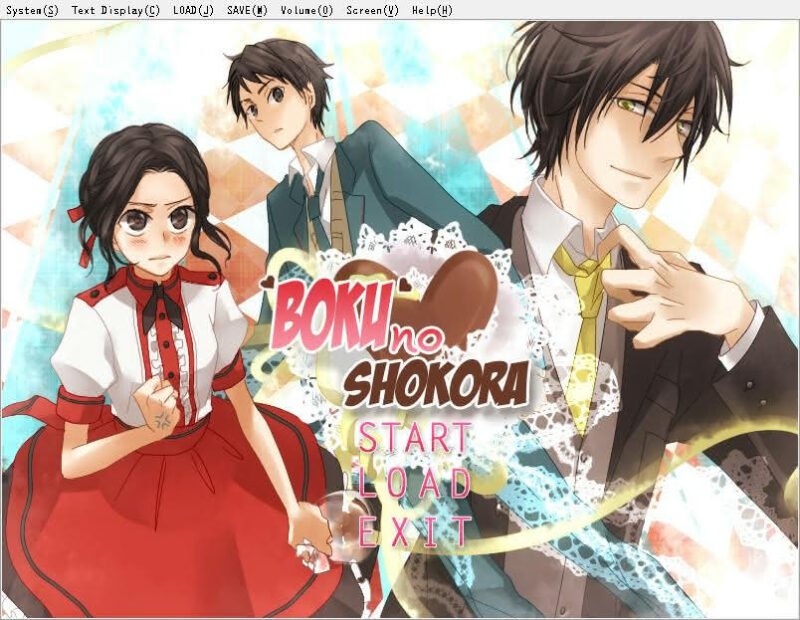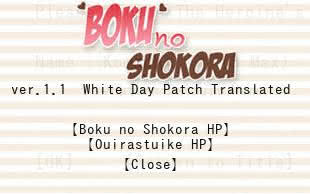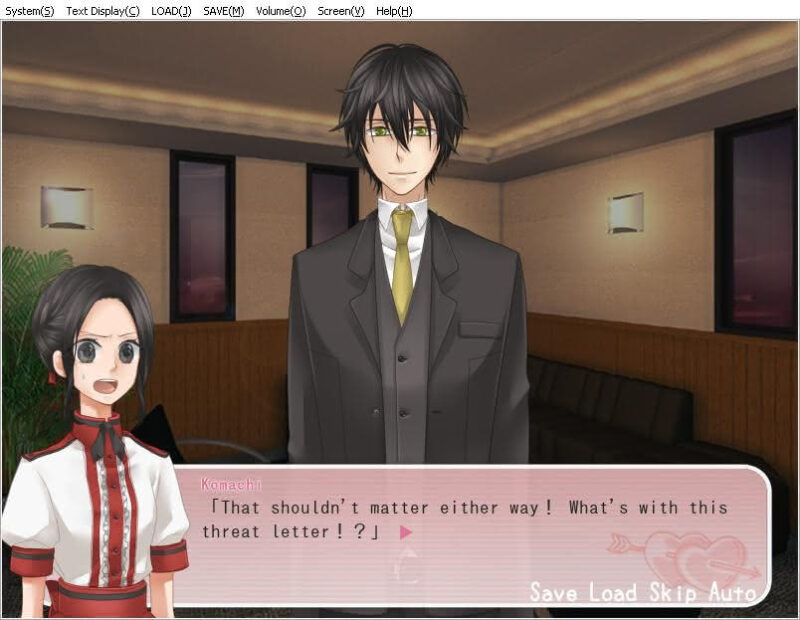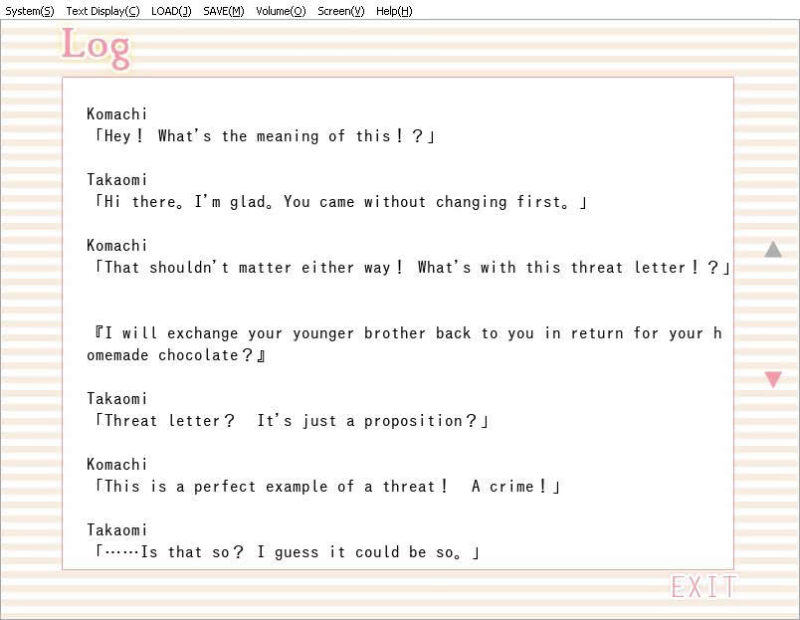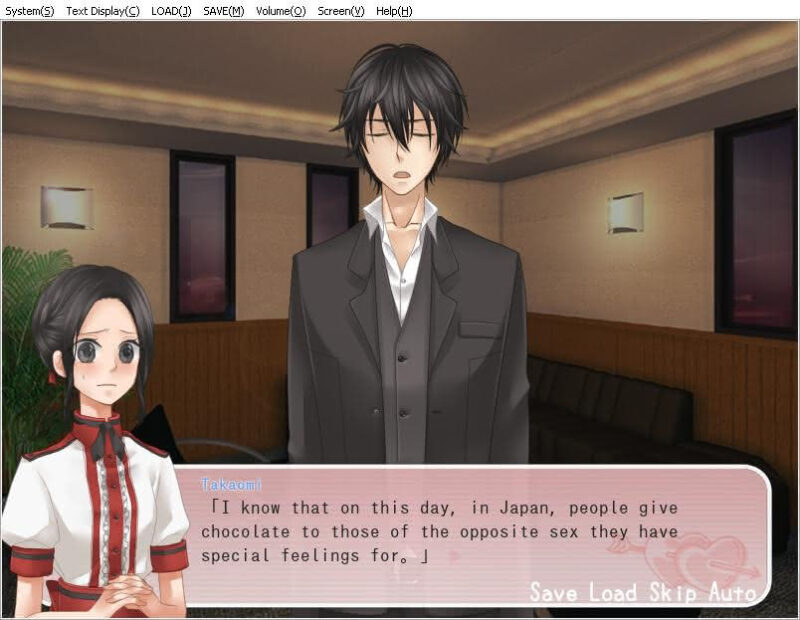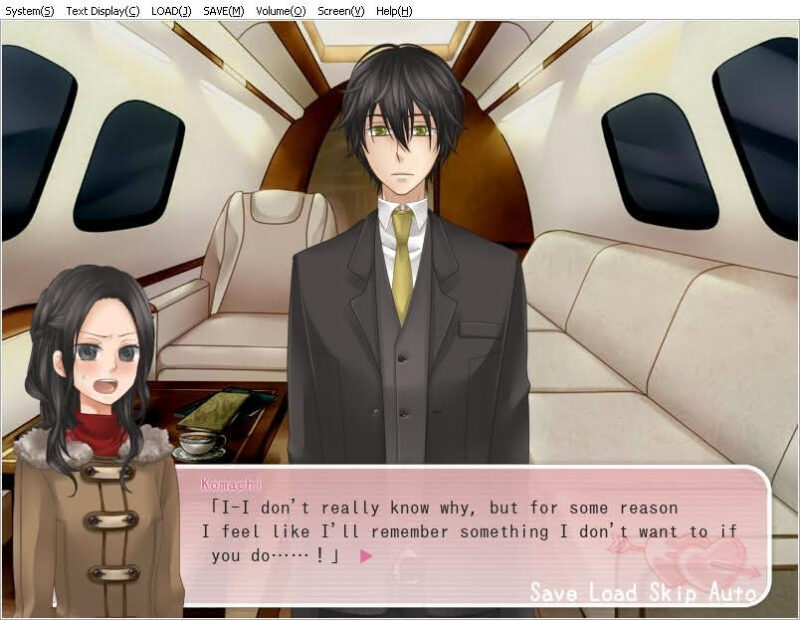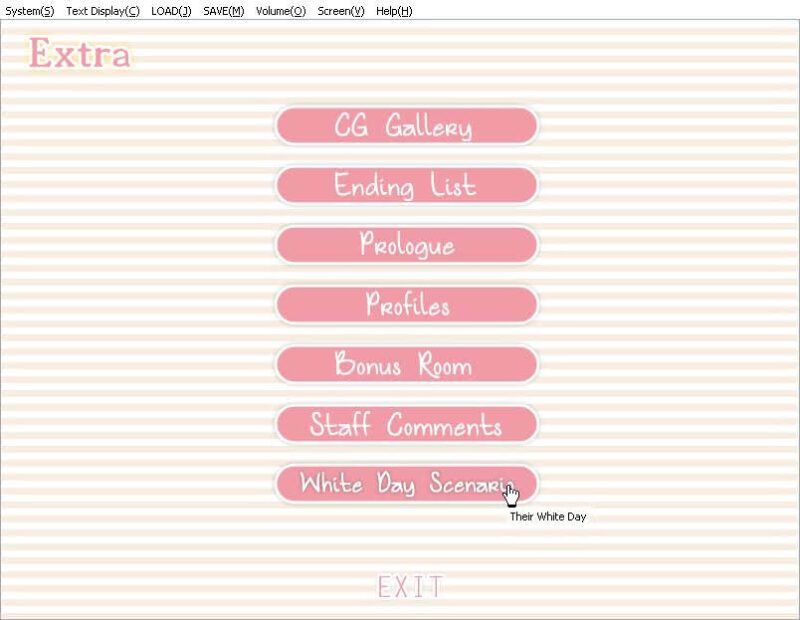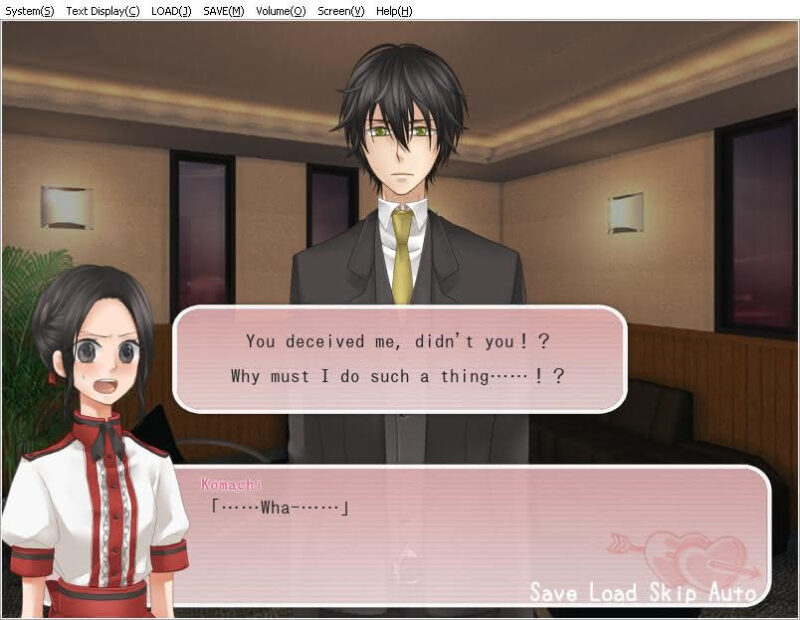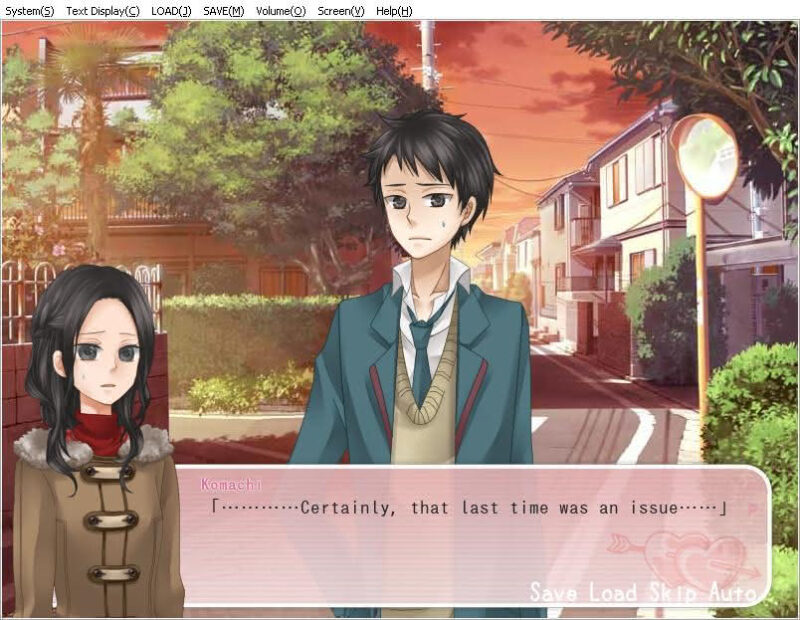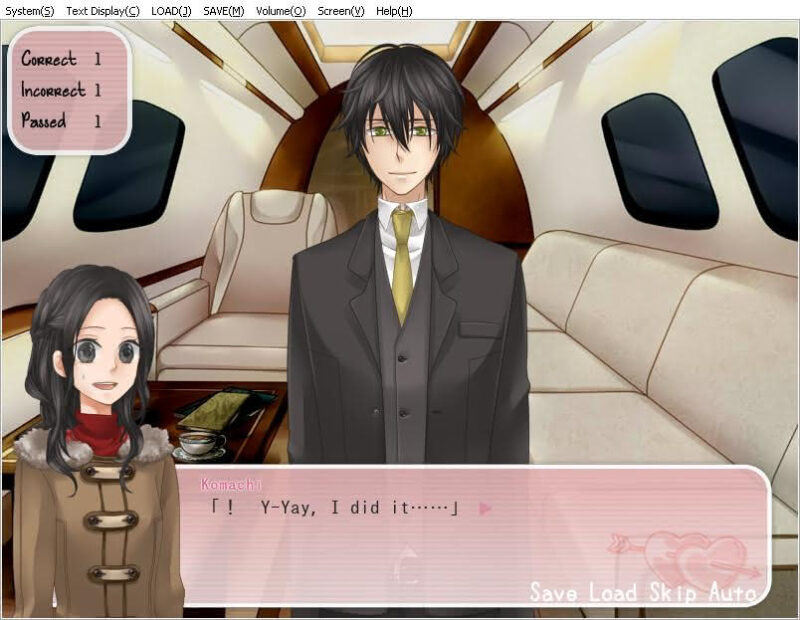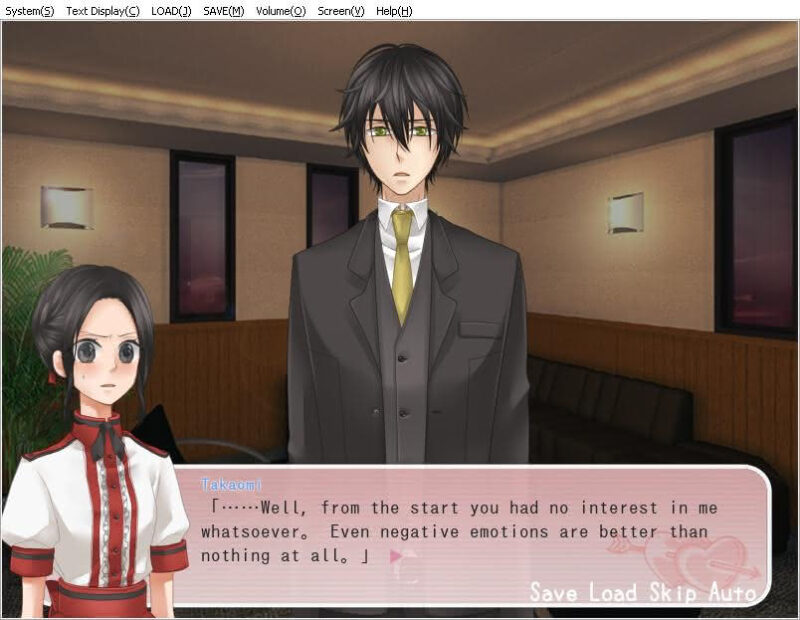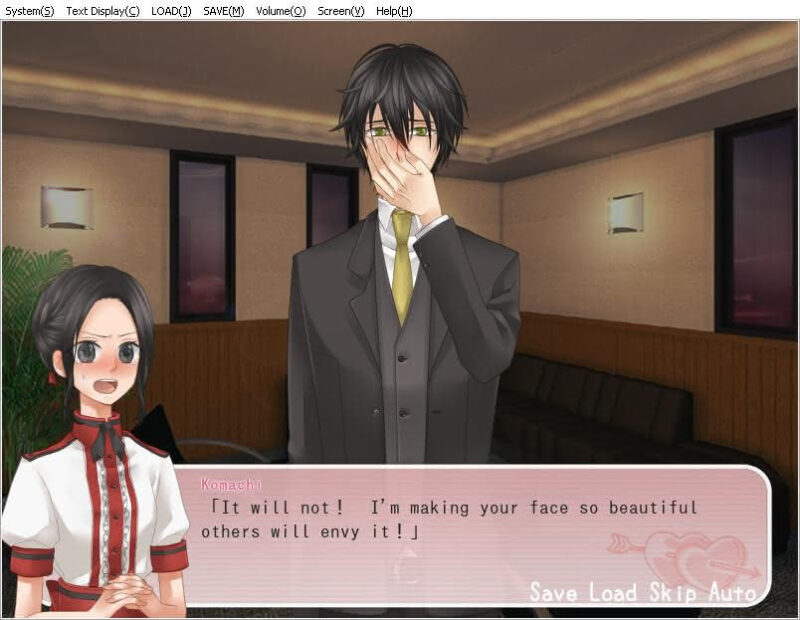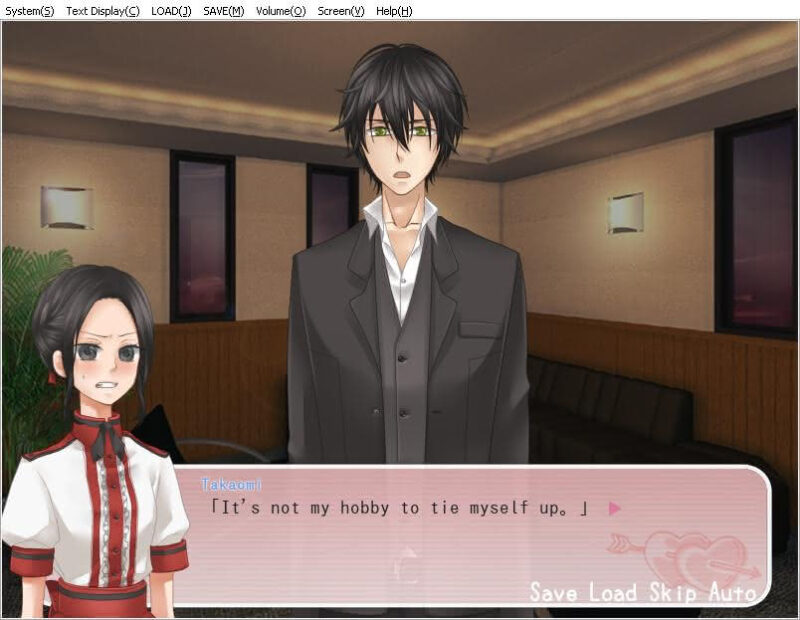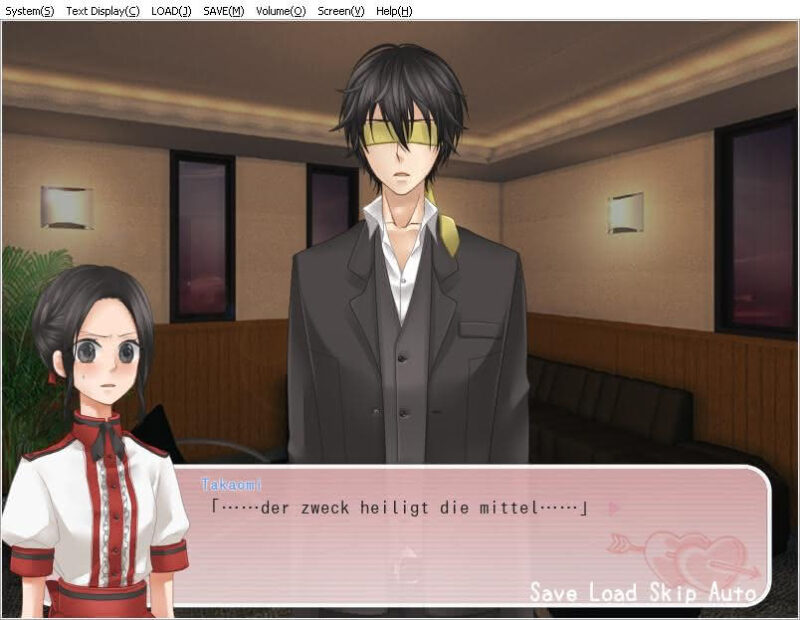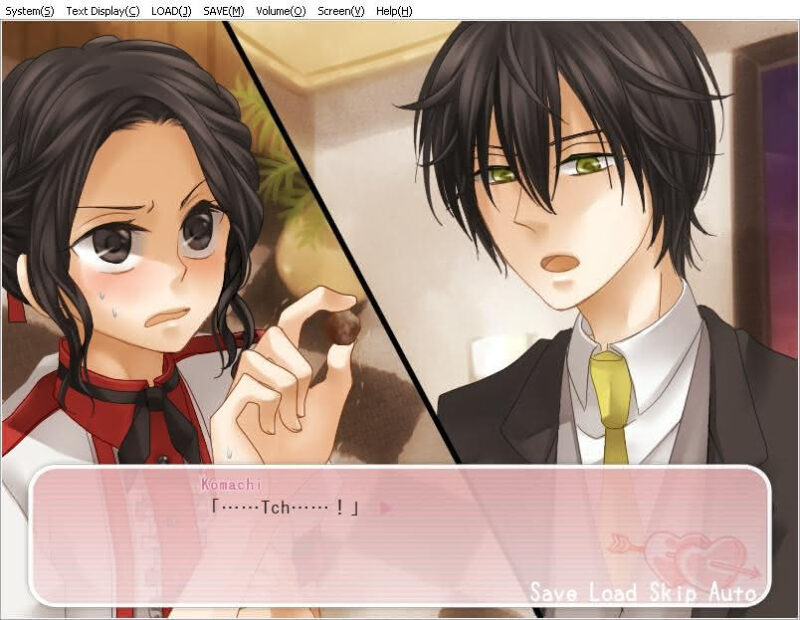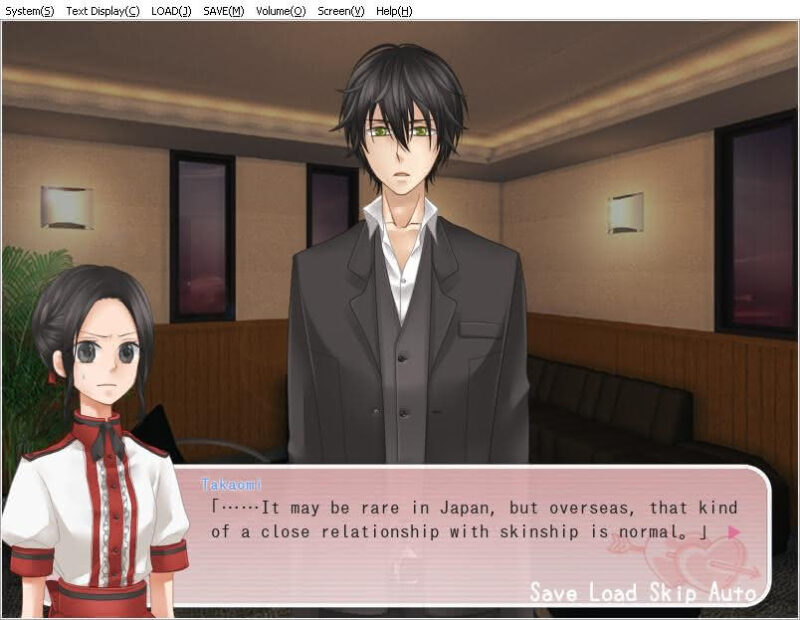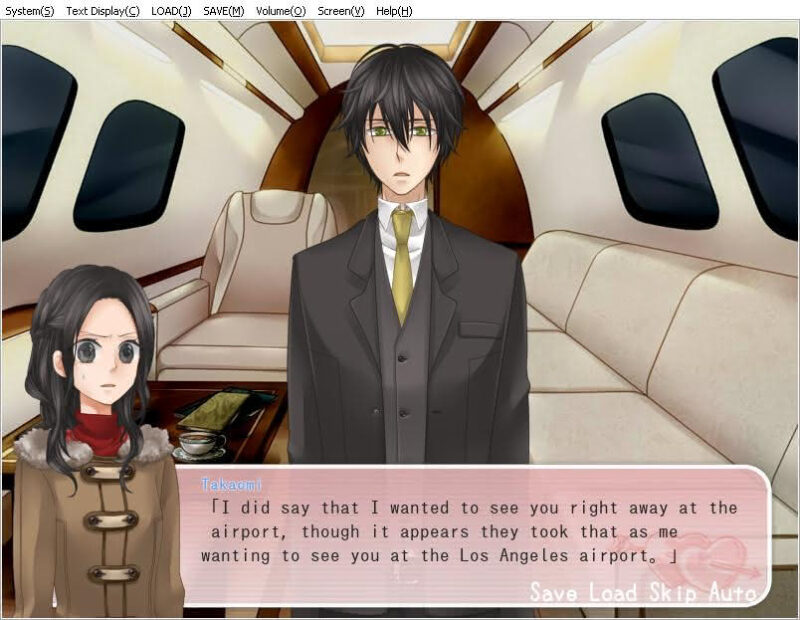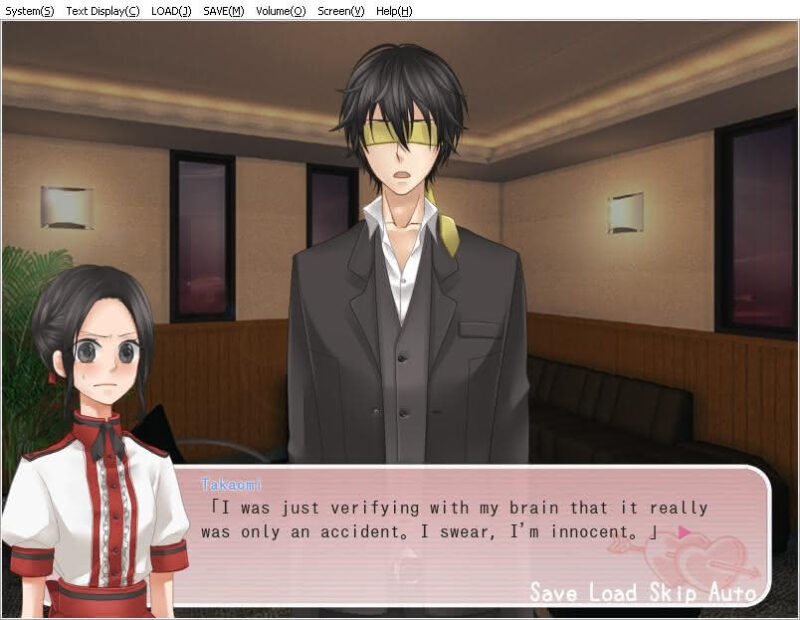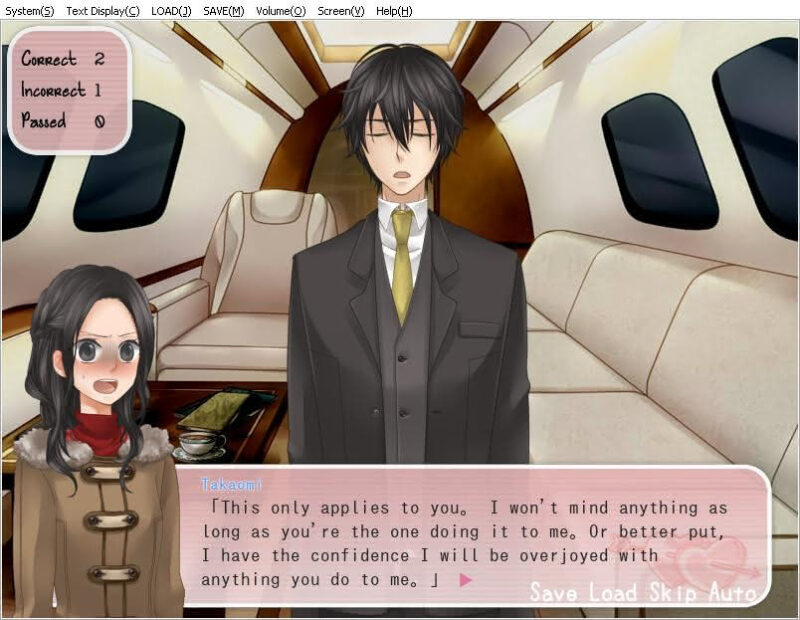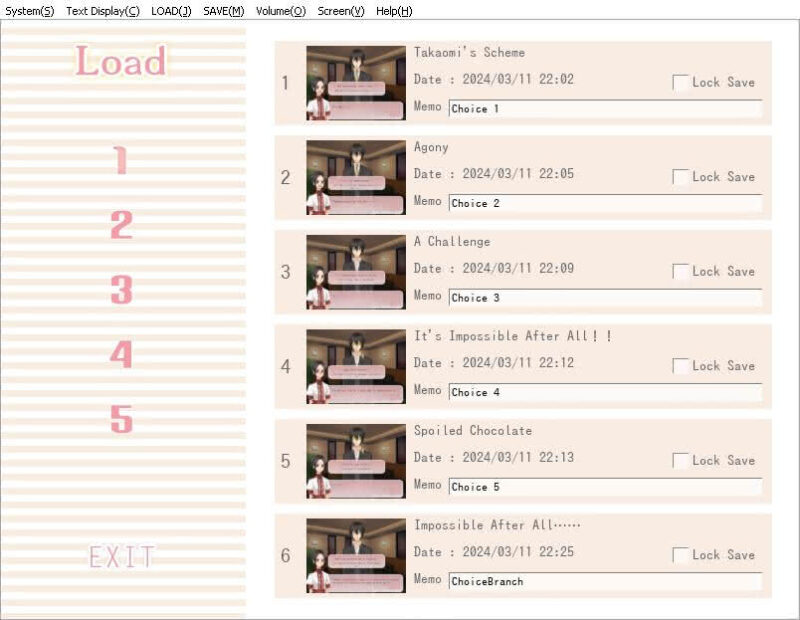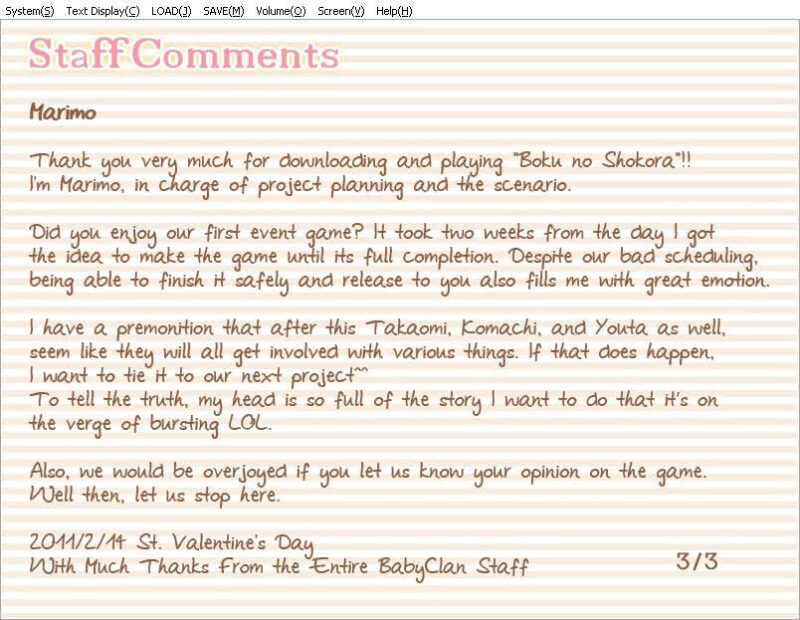White Day is a Japan-exclusive counterpart to Valentine’s Day. Landing on March 14, it has boys reciprocating the gifts of Valentine’s chocolate that they had received from girls. Having reviewed a visual novel with a distinctly Valentine’s Day setting on February 14, I decided to use the Visual Novel Database to look for a visual novel that features White Day for a March 14 review. I came up with Boku no Shokora, the 2012 unofficial English-language translation of a 2011 doujin Japanese visual novel called Boku no Chocolat.
Boku no Shokora will be our first review of an otome visual novel – which features a female protagonist managing her usually dreamy male suitors. In this case, we take the role of a 19-year old junior college student (her default name is Komachi but the player can change her name). She works as a waitress and is being courted by Takaomi, a wealthy, attractive, half-foreign 24-year old young businessman. For whatever it is worth, this 3D man would not recommend dating Takaomi to 2D or 3D women (Komachi’s younger brother Yuta definitely agrees with me).
The original release of Boku no Chocolat takes place on Valentine’s Day. However, the team released an update several months later which adds a White Day scenario to the game. Fortunately, the English version includes the original game and the White Day scenario as an additional download patch, so we will review both versions.
Boku no Shokora Details
Original Japanese Novel
| Title | Boku no Chocolat |
| Creator | BabyClan (circle) |
| Original Release | February 14, 2011 |
| White Day Scenario | May 1, 2012 |
| Engine | KiriKiri 2 / KAG 3 |
| Official Website | Archived |
The archived BabyClan website indicates that the latest available version of Boku no Chocolat was 1.2. I know from the English translation that version 1.0 was the 2011 release and the White Day patch constitutes version 1.1. From using a machine translation of the website, I think version 1.2 consolidated the patch with the original game into a single release, but I have no way of knowing whether there were any modifications to the Valentine’s and/or White Day scenarios that post-dated the English translation.
English Translation
| Title | *Boku no Shokora |
| Translators | Ouiratsuike (circle) |
| Version 1.0 Release | February 4, 2012 |
| Version 1.1 Patch Release | March 4, 2012 |
| Engine | KiriKiri 2 / KAG 3 |
| Official Website | Archived |
The English release consists of two translations. Circle Ouiratsuike first released its translation of the original Boku no Chocolat. One month later, it released a translation of the White Day patch which can be applied to the translation of the base novel. Note that the patch translation is not a stand-alone product – it requires the version 1.0 translation to run.
Downloading and Running Boku no Shokora
The official website for the translation circle, Ouiratsuike, is no longer live. However, the download links for Boku no Shokora and the translation patch are hosted on Mediafire and still work. See the download links below:
Boku no Shokora is written in KiriKiri. Like all of the KiriKiri games we have reviewed thus far, it is only native to Windows. I run Linux and was able to run Boku no Shokora with its patch on top of WINE without any issues. I will explain the process – Windows users should note that it should work the same there sans the steps I describe about using WINE.
First, download Boku no Shokora and the White Day patch. Second, unzip both archives, open the White Day directory, and copy the ‘patch.xp3’ file into the Boku no Shokora directory (it should be in the same directory as ‘Boku no Shokora.eXe’). The patch applies itself automatically so long as it is in the same directory as the novel’s executable. According to the novel’s Readme instructions, the patch can be “applied” at any time.
Boku no Shokora requires a Japanese language environment to run. I previously explained how to configure one on Linux with three WINE helpers: PlayOnLinux, Lutris, and Bottles. You can see how I configured it in Lutris here:
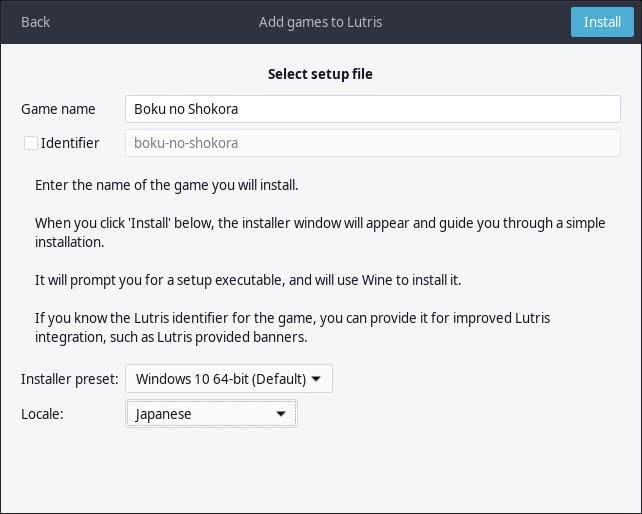
Using Lutris, I selected the option to run a locally installed game (the ‘Boku no Shokora.eXe’ is not an installer so it does not need to be installed).
Boku no Shokora ran perfectly for me on Linux without any special configuration after I completed these steps. I did not need to install any additional Japanese fonts beyond what I have on my system (contrast with Collage and Until We Meet Again). I did not test it on Windows, but I assume that in light of the fact it is a Windows game, it should run well with a Japanese environment. MacOS users would have to try it with WINE using similar steps to what I used to run it on Linux.
If you want to double check that the patch was applied correctly, you can press “Help” on the top menu bar during game play (it is the right-most option). This will open a small window that includes version information. If the patch is being applied, you should see the following:
The key is the version number. The patch is version 1.1. The original without the patch is version 1.0.
Note on the original Japanese game
The official website for the circle behind Boku no Chocolat is no longer maintained (it is well-archived, however). I could not find working download links for the original Japanese novel (the Wayback Machine did not capture the download links). I would not be surprised if the last version of the Japanese novel is floating around, especially since the developer was active until fairly recently, but s a search for it would be aided by knowledge of Japanese.
General Introduction to Boku no Shokora
The player takes the role of a 19-year old junior college student who is working as a waitress. Her default name is Komachi, but the player can also change her name in the main game (not in the White Day scenario). We start with Komachi having received a Valentine’s Day letter from a wealthy 24-year old man named Takaomi. Takaomi had left Komachi a letter stating that he would exchange her younger 16-year old brother, Yuta, for homemade chocolate. Komachi understandably took this as a threat but Takaomi insists he just wants homemade chocolate.
Komachi does appear to have feelings for Takaomi despite her unease with the fact that he relies on lavish gifts and outlandish behavior – such as kidnapping her brother – to show his affection for her instead of just telling her how he feels in plain English (or Japanese, since this is a Japanese visual novel). So, she does bring him the homemade chocolate. Tamaoki has staged this stunt at an expensive hotel and it appears that Yuta has involuntarily been given a nice room there.
However, after confirming that Komachi brought the homemade chocolate, Takaomi modifies the arrangement, insisting that Komachi feed him the homemade chocolate. Komachi feels double-crossed, and what ensues is a battle of wills (and of Komachi’s straight right hand and Takaomi’s face) and Takaomi’s numerous unsuccessful attempts to complete the new arrangement he seeks.
(I hope Yuta at least had TV in his hotel room while Komachi and Takaomi engaged in their chocolate battle.)
The White Day scenario (unsurprisingly) takes place exactly one month after the Valentine’s Day incident. Having introduced White Day, one can infer that since Komachi gave Takaomi chocolate on Valentine’s Day (setting aside the underlying circumstances), Takaomi would return the favor on White Day.
The White Day scenario’s set-up is largely foreshadowed in three out of the four possible Valentine’s Day scenario endings, but we will set that aside for the time being.
Boku no Shokora Review
Below, I offer my full review of the different parts of Boku no Shokora. Per my custom, this review is intended to be amenable to reading by people who have not read Boku no Shokora but may be interested in doing so in the future. With that being said, Boku no Shokora is mostly built on a couple of extended jokes and does not have a serious story, so I will not be quite as careful in what I choose to say as I was in my recent review of the story-rich (and genuinely excellent) True Remembrance. If you are already set on playing or reading Boku no Shokora, you may consider bookmarking my review and reading the rest after you are done – but I leave that up to reader discretion.
Estimated Reading Time
Visual Novel Database players gave Boku no Shokora a reading time estimate of just under an hour. That seems about right to me assuming that the reader is aiming for 100% completion (i.e., all 4 endings in the base novel and all 7 endings in the White Day chapter). One’s ultimate reading time may depend in part on how quickly he or she figures out the required choices for triggering the different endings. The extra content consists of short comments from the three members of BabyClan who made the novel and do not add much to the overall word count.
A note on Komachi’s name
Boku no Shokora allows the player to name the heroine in the base Valentine’s Day game. By default, her name is Komachi.
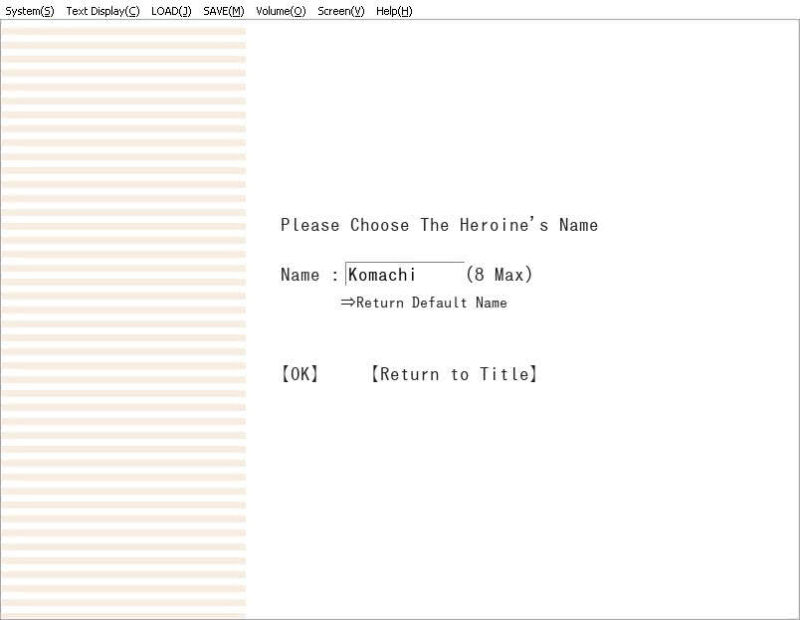
I stuck with the default name and I think Komachi suits her well. The translators recommend that players do not make her name longer than seven letters (notwithstanding the 8-letter maximum). It states that the game would still work but it is possible that giving her a longer name will cause some unexpected behavior in line breaking.
For the purpose of this review – I will refer to the heroine as Komachi. But note for reference that her name can be whatever the player wants to be – preferably seven letters or less.
Base game vs White Day chapter
Assuming you install the patch, Boku no Shokora has two halves. There is the base game, which I will often refer to as the Valentine’s chapter, and then the extra White Day chapter or scenario. The White Day chapter cannot be played without first playing through the Valentine’s chapter, which I did. (Note: I forgot to check if the White Day chapter was available after clearing Valentine’s only once or if I needed to complete all four Valentine’s endings.) After clearing the main game, the “White Day Scenario” can be selected from the novel’s extras menu:
White Day CG scenes and Endings are available from the Extras menu in the same way as the main game CGs and Endings.
Note that while the White Day scenario takes place after the main game and references it, the play-throughs are unrelated. That is, the White Day chapter is not tied to any particular ending or choices from the Valentine’s Day base game.
Game-play and structure
Boku no Shokora is a relatively interactive visual novel compared to most of the pieces that I have reviewed at The New Leaf Journal thus far. Both the base Valentine’s Day story and the extra White Day chapter feature a number of choices and multiple endings. The choices work a bit differently in the two chapters.
Base Game (Valentine’s Day Chapter)
The Valentine’s Day chapter must be completed in order to play the White Day chapter. In any given play-through, the player will be asked to make five choices with each choice consisting of two options. With that in mind, I will explain roughly how we get to the four distinct endings.
The novel has what we can call a common route. The common route includes the first three choice prompts. No matter how the player handles these three choice prompts, they will always be the same options.
The player’s decisions in the common route – or in other words the first three choice prompts – places the player on one of two routes. For simplicity’s sake, we will call these Route A and Route B.
Both Route A and Route B have two choice prompts. However, the prompts are different in Route A and Route B.
Both Route A and Route B each lead to two of the four total endings. This means that two of the four endings are accessible from Route A only and two of the four are accessible from Route B only.
The player’s ultimate ending depends on (1) whether he or she ends up on Route A or Route B; and (2) the player’s two choices in Route A or Route B.
It is possible to save choice prompts and Boku no Shokora has very good skipping functionality for previously-seen text, so once the reader can trigger Route A and B, it is relatively easy to reach all of the endings with less difficulty than Komachi and Tamaoki have in resolving their chocolate feeding battle.
Each ending consists of a short scene. Three of the four are a scene that takes place just after Valentine’s Day while one is a set of CG scenes on Valentine’s Day.
I will note that the outcome of the Komachi-Tamaoki battle is similar in all four cases as are the take-aways. I would describe the endings as minor variations on the same general conclusion. There is no “good end,” “true end,” or “bad end.”
White Day Scenario
The White Day chapter is shorter than the Valentine’s Day story but it has a more complicated choice structure leading to more endings.
Here, Takaomi makes Komachi take a quiz. The quiz has five questions. Komachi loses if she gets two questions wrong and she wins if she gets three questions right. She is also allowed to “pass” on a question but can only use the pass option once. Depending on Komachi’s answers, there will be different numbers of choice prompts. For example the game can end after two choices or it can in some cases have more than five.
The White Day chapter has a total of seven endings and all of the endings follow from different quiz game outcomes. The general idea is to try different combinations of right, wrong, and passed answers to make the quiz end at different points and in different ways. I would recommend keeping track of which choices lead to endings in order to quickly try all of the different combinations. I will note that most of the possible endings are similar to one another but two stand out from the rest.
Visual Presentation
Almost all of both chapters take place in a single location – the Valentine’s Day scenario in a hotel room and the White Day scenario on a plane. For this reason, both chapters use a single background. Three of the short endings for the Valentine’s Day scenario use different backgrounds. These include a restaurant and a couple of outdoor backgrounds. The backgrounds are done well enough but having 95% of a nearly-hour long novel take place in two locations represented by two static backgrounds does not make for an exciting visual experience.
While the background diversity is lacking to say the least – the character designs fare better. Komachi, whom the player controls, has a full portrait occupying the left side of the screen. Takaomi takes center stage with a larger portrait in the center of the screen. Yuta replaces Takaomi in two of the four ending scenes for the Valentine’s Day scenario, but his role is as minor as his luck is sub-par.
I like Komachi’s design. We see her in two outfits – her restaurant uniform in the Valentine’s Day scenario and with a coat and sweater in two of the four Valentine’s ending scenes and in the White Day chapter.
The character designer – Watari – did an excellent job with Komachi. She is cute but looks plausibly like a 19-year-old adult. Watari also showed some attention to detail – giving Komachi a different hair style when she is dressed for work as a waitress than when she is off.
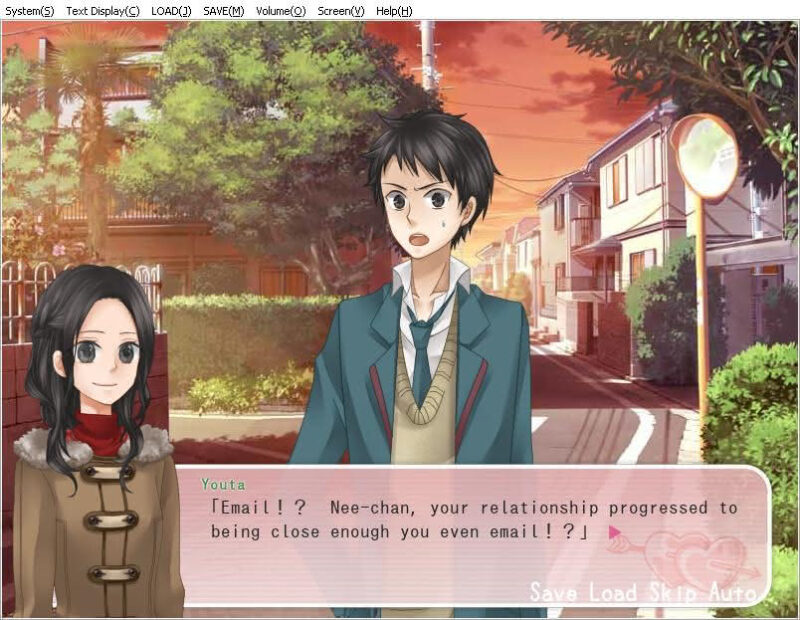
But where Komachi really shines is her vast array of facial expressions – most of them evincing some irritation with or embarrassment regarding Takaomi. I did not count all of her expressions – but some are different in subtle ways. For example, there are different variations of Komachi’s grimace distinguished by how narrow her eyes are. I dare say no novel I have reviewed did more with a character’s eyes (their decision to give Komachi gray-black eyes works well too). Komachi’s design reminds me very much of Kaguya from the Kaguya-sama: Love is War anime and manga (Komachi predates Kaguya by several years, so she is not derivative).
Takaomi is also well-designed. He is an odd, rich young-man who behaves in absurd ways that are not always in accord with the “values of society” (to quote Komachi). His joke is that he says silly things completely deadpan and without a hint of shame. His narrow range of facial expressions conveys this well and, like Komachi, includes subtle changes that convey his changing mood. His outfit also goes through some less subtle changes.
We meet him with a three piece suit, but he usually ends up in his without a tie for one absurd reason or another. Watari seemed to like Takaomi the most – but I think Komachi has the more memorable design.
We only see Yuta in his school uniform and, as I noted, he only appears in a couple of scenes. Yuta looks very much like a typical high school kid. He is generally exasperated with his older sister in his few scenes (for good reason) and this is reflected in his design.
Boku no Shokora features eight CG scenes, most with more than one frame. The CG scenes are all high quality (among the better I have seen in the freeware novels I have reviewed). The most common is Komachi punching Takaomi in the face.
Followed by her failing to deliver chocolate to Takaomi.
The rest of the CG scenes are related to different endings, so I will not include them in this review.
Boku no Shokora has a cohesive, stylish UI that is among the better we have seen in a freeware doujin piece. I like the two hearts with an arrow in the bottom right of the pink text box just above the Save, Load, Skip, and Auto options. My only UI complaint is that the colored character names lack contrast against the textbox. They are not hard to read but the styling is not as good as it could be.
In the final analysis, Boku no Shokora features excellent character-design work but the overall visual presentation is hindered by the fact that almost the entire novel plays out against two backgrounds.
Audio presentation
Boku no Shokora has a sparse collection of what I assume are freeware music tracks. None of them bothered me but, having finished the game within the previous 48 hours, I would be hard-pressed to remember any of them.
The sound effects are also limited. I noted a footstep sound effect at the start of a novel, Komachi’s punches, and a phone sound effect – but there is little to write home about in the sound department.
Translation analysis
Before discussing the localization, I append my usual disclaimer that I do not know Japanese and thus cannot compare the English version to the Japanese version. My analysis is solely based on my reading of the English script.
Having noted I cannot assess the translation against the original Japanese, I can say without hesitation that Boku no Shokora is among the weaker-reading English scripts that I have covered. Save for a couple of instances late in the Valentine’s and White Day scenarios, I never felt like Boku no Shokora was difficult to understand – which was perhaps aided by the fact that the entire novel is an extended joke (on the whole, the White Day scenario reads a little bit better than the base Valentine’s Day story). But the English is clunky, especially in the latter stages of the Valentine’s scenario.
There are many examples of odd word choices. I will limit myself to a few. Komachi says “I brought my chocolate under such a pretense” when she really just means to say that Takaomi added a condition for returning her brother. “I have no immunity to resist” made no sense at all. Her response to one of Takaomi’s confessions – “Lightly saying ‘I want to be with you’ and such is troubling!” also sounded odd. This is not how an ordinary English speaker would phrase the sentiment. Komachi likes describing Takaomi as being “exorbitant,” but it never sounds quite right. On Takaomi had a few odd lines. For example, when he was explaining to Komachi that Europeans may be more touchy when greeting each other than Japanese people (the implication seemed to be a hug), he said “It may be rare in Japan, but overseas, that kind of close relationship with skinship is normal.” That is awkward on many levels. Another line of his, “I also have a side that is lacking the right words to say,” is in itself lacking the right words in the right order. One ostensibly important line, “My lack of words to say to you is probably far greater than the time I think about myself,” is impossible to diagram.
The issue is not that the novel is difficult to understand but that it too often reads like a conversation between two people who know English words but do not use them like native speakers. Whether the issue stems from an attempt to make the translation unduly literal or a lack of comfort with conversational English is unclear. The script still delivers most of the jokes adequately, but it is impossible to not notice how oddly it often reads.nAs a point of comparison, this English script is weaker than all 31 of the al|together localizations but it is comparable in quality to two commercial novels I reviewed, Bad End and LoveChoice.
Having noted my critiques, I submit for the record that I am grateful that the translation, flaws and all, was done at all. This project, which was done for no financial gain and in order to make Boku no Chocolat available to English readers, is the only reason why I could read and review the novel at all. Moreover, as I noted, it compares favorably to some visual novels on Steam that actually cost money, if not to some of the uniquely strong localizations that were submitted to al|together.
Writing and story assessment
Here, I will try to set the issues with the awkwardness English script aside and assess the script and jokes (noting this game is comprised of one or two extended jokes) on their own merits.
Understanding what Boku no Shokora is going for requires some context (my article on height differences in anime romances makes for good reading here). Otome media tends to feature a young lady who draws the attention of dreamy guys. The young lady is typically normal – pretty enough for all normal purposes but not stunning. She may be bright, but she is probably not a genius. Her interests and hobbies are probably normal and unexceptional. One of the common plots is that the relatable heroine suddenly, unexpectedly, obtains one (or many) stunning gentleman suitors.
That is what we have here. Komachi seems to be a normal college student working as a waitress. She is cute, but there is no suggestion that she is going to be discovered by a modeling agency. The novel does not note her being unusually intelligent or interesting. She is more than a bit dense about romantic feelings but enough of a dreamer that she does not run away screaming from Tamaoki. Unlike some protagonists in these sorts of things – she does have one defining characteristic. She packs a mean punch, and we learn she cultivated that by protecting her younger brother when they were kids. It is this punch, we learn in a prologue, that brought her to the attention of Takaomi.
Takaomi is the “dreamboat” (and sole) suitor here. He looks attractive and we are told Komachi notes his “finely chiseled face and slender physique.” Komachi describes him as the “distinguished son of a corporation” and explains that he grew up in Germany before returning to Japan with a significant about of money. She believes that he does not understand societal values or how things work in the normal world. To be sure – this is all accurate, Takaomi is portrayed as oblivious to ordinary behavioral norms. He evidently fell in love with Komachi’s wicked right hand and expressed his affection for her by constantly visiting the restaurant at which she worked and lavishing her with gifts. One odd point that is worth noting: Komachi presumes that Takaomi is strange because he grew up in Germany. To be sure, the novel does have a hint of the stereotypical “weird, overly familiar foreigner” trope that is not uncommon in this sort of media (seldom to the benefit of said media). But at the same time, Takaomi ’s initial inability to put his feelings into words, instead relying on comparatively indirect ways of conveying that he is in love with Komachi, is the sort of behavior associated with Japanese characters in these sorts of romances when things need to drag out – and Takaomi s flaunting his extraordinary financial means is a typical twist on the formula when wealthy characters are involved.
No one should try to take Boku no Shokora seriously – it is at its heart a comedic otome game. But since this is a script analysis, I will give it my best shot. The basis for the jokes in both parts of the novel is miscommunication. Komachi is just about won over by Tamaoki’s over-bearing affection, as weird as he is, but she is not comfortable saying as much until Takaomi expresses his feelings like a normal person. Takaomi is desperate for Komachi to like him and, not realizing why she feels uneasy about opening up to him, resorts to increasingly showy displays to try to turn things in his favor. Their issues are aired out in the midst of the attempts at absurdist comedy in the main Valentine’s Day chapter, and articulating one’s feelings is the point behind the joke “quiz” in the White Day scenario.
The creators of Boku no Chocolat (the original Japanese game) decided to pile multiple otome tropes atop one another until they had a tower.
My overall impression of this piece is decidedly mixed, but I will lead with a positive point in the interest of positivity. The handling of the Valentine’s endings is clever. Similarly-structured pieces such as another four-ending game with a similar (albeit less complicated) choice structure, hallucinate in The world to reverse. That short novel had four endings and one was clearly the good end. In the case of Boku no Shokora, the Valentine’s Day chapter’s endings are all similar in terms of the actual outcome. This allowed Boku no Shokora to write the White Day scenario in a way that plausibly follows from any of the four endings (one could make a case it would not naturally follow from one of the four but that case would rely on reading unduly deeply into the dialogue). This is not a Kaori After Story follow-up to the six-route ACE Academy where the extra chapter necessarily follows from one and only one ending.
Setting aside the clunky English, my issue with Boku no Shokora is that it does not fully commit to a path. It is clear that the writers actually liked both of the main characters (they state as much in the extra commentary, discussed in the next section). That is, while the game is not supposed to be taken in any way seriously, one does get the impression that the novel wants readers to be somewhat invested in seeing the best outcome in the White Day scenario, or at least one that promises to end with Komachi and Takaomi together.
The problem, as I see it, is that they made Takaomi too weird, too bizarre. This issue lampshaded by Yuta in two of the four Valentine’s Day endings when he correctly warns his older sister that Takaomi is a weirdo and that everything involving Takaomi will invariably lead to someone being kidnapped. To be sure, Yuta is probably a little bit bitter about the fact he was confined to a hotel room because Takaomi wanted chocolate from Komachi and because Komachi continued to be interested in Takaomi, but was he wrong? No.
Takaomi is weird to the point that it is difficult (to put it mildly) to have any investment in a good ending. In addition to being weird, it is hard to find any redeeming qualities in him other than that he is handsome and financially successful. That Yuta’s fair points of criticism and warning are rejected by Komachi adds another element to it being difficult to want to see the good end. I suggested that Komachi looks like Kaguya in the very popular Kaguya-sama: Love is War series. I discussed the third season of the anime in my 2022 anime year-in-review, where it was my runner-up selection for anime of the year. While that is a very different romantic comedy (especially in scope), it is a good example of what I am getting at here. Much of Kaguya-sama , especially the early stages, features a battle of wills in which the main would-be couple, Kaguya Shinomiya and Miyuki Shirogane, try to make the other confess. Both are hyper-competent to outsiders but a complete mess when it comes to expressing their feelings (whoever confesses first loses). The skits are often absurd. But all the while, the series takes time to make the difficult duo sympathetic (granting that Kaguya can be difficult in her lesser moments) such that it is satisfying to see them eventually make real progress. It is clear that they should be together. Granting again that Boku no Shokora is a short novel instead of a long-running manga and that it is technically a different genre (Kaguya-sama is not an otome series outside of a single hilarious skit in the second season and its primary target audience are not women/girls), I think that Boku no Shokora would have done well to tone down Takaomi enough such that it would have been possible for readers to have some investment in his and Komachi’s articulating their feelings. How could this have been done? At a minimum, I would have not re-used a variation of the kidnapping set-up for the White Day scenario since that serves as the conclusion to the project. On the whole, I would have chosen a different set up entirely (while I sympathize with Yuta, his involvement was not necessary) that would have still led into the chocolate war and quiz game but would not have made Takaomi quite so maladjusted.
However, having made Takaomi weird on top of weird, it is hard to be at all invested in what is happening. We are left with something that can only be understood as an extended genre joke. It is possible to turn a joke into a good piece – see the excellent and very short Crimsoness as an example or Save the Date in the context of a game centered on dating. I will grant that Boku no Shokora does have its moments of comedic inspiration, even granting that they are all of the predictable “flustered Komachi says something, gets deadpan response, and becomes more flustered and/or violent” variety.
But these moments are just that, moments.
There are stretches in both scenarios when it feels like we are waiting for something funny to happen, but the characterization of the main pair leaves us with little else. Moments aside, the piece is not quite funny enough to be carried by comedy alone and it lacks the substance to have an ending other than comedy. Boku no Shokora finds itself existing in a strange in-between place. It is not a bad one-time read, but there is little to incentivize one to see it through to the end other than checking off all 11 endings in the Extras menu. Speaking of which…
Extras and other notes
Boku no Shokora comes with the typical KiriKiri user interface that we have seen in other KiriKiri games, old and new. One thing I appreciated was that its save menu allows for notes with saves, a feature we previously saw in Collage and True Remembrance. There are more than enough save slots utilize at all meaningful choice junctures.
The novel features a robust post-completion Extras menu (this is where I noted you will find the White Day chapter). Setting aside White Day, I will walk you through the other options:
- CG Gallery (The CG scenes are added as they are encountered in game-play.)
- Ending List (Endings from the main game and White Day are added as they are unlocked. One neat feature is that you can watch the special scene for each ending from the list menu.)
- Prologue (A short chapter with no choices seen from Takaomi ’s perspective. We learn how Komachi unintentionally caught his eye and about the events leading to a certain Valentine’s Day.)
- Profiles (One page of short profiles for Komachi, Takaomi, and Yuta. They add some minor information about the characters beyond what we see in the main stories.)
- Bonus Room (This is a link to BabyClan’s Japanese website. Unfortunately, the link is now dead but you can see an archived copy of where it went here.)
- Staff Comments (Probably the most fun “Extra.” We get commentary from the writer and main developer, the character artist, and the background artist.)
The staff comments are my favorite extra. One remarkable note is that the entire base novel (everything before the White Day chapter) went from an idea to completion in two weeks.
I was impressed when I read that given that it is a very polished final product setting aside some of my qualms about the script.
Final Assessment
I stumbled upon Boku no Shokora in a quick search for a visual novel with a White Day focus that is available for free (or at least cheap) in English. It was fun after employing a small amount of detective work to find what is probably a little-known piece (albeit it has been translated into other languages and has more Visual Novel Database reviews than many of the al|together translations), and I was able to download and run it. While I had issues with the shaky English and some of the choices the novel made in setting up its plot, it was an interesting read from my perspective as someone who has made it a project to read these sorts of freeware Japanese novels. That BabyClan completed the original piece in two weeks(!?) is genuinely impressive, and the character designs and portrait variety for Komachi and Takaomi stand out from many similarly-produced projects that I have read.
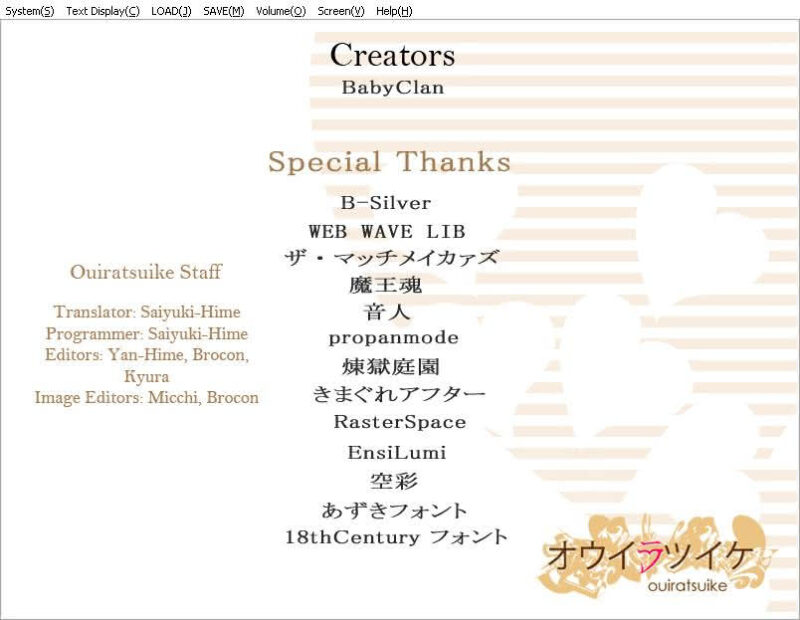
While I would not offer Boku no Shokura as a general recommendation like I did for some of the better al|together novels I reviewed (this one would have landed somewhere close to 20 in that ranking), it is worth a look for fans of the genre, people with a general interest in doujin novels, or anyone who thinks the premise sounds amusing.
